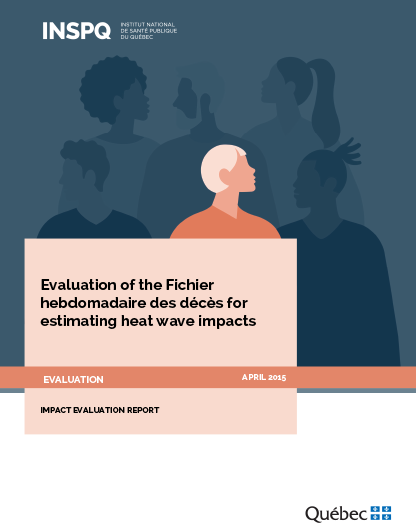Evaluation of the Fichier hebdomadaire des décès for estimating heat wave impacts
Since the 2010 summer season, the Institut national de santé publique du Québec (INSPQ) has been producing an annual report on the impact of extreme heat waves on the health of the population, using the Fichier hebdomadaire des décès of the Institut de la statistique du Québec (ISQ). The main purpose of this study is to verify the validity of this data source. The study also aims to measure the impact of age, material deprivation, and the presence of urban heat islands on the frequency of deaths during extreme heat waves.
A useful monitoring tool
- The validity of data from the Fichier hebdomadaire des décès was assessed by comparing the impacts of the 2010 and 2011 heat waves with those obtained using the Registre des évènements démographiques (RED).
- The results indicate that the Fichier hebdomadaire des décès systematically underestimates the impacts of heat waves. To remedy this problem, it is suggested that more permissive statistical criteria should be applied in interpreting the results of the annual reports.
- The Fichier hebdomadaire des décès is a useful tool for monitoring the health impacts of heat waves, provided that the data are extracted at least four months after the end of the monitoring season. Unless this time frame is observed, the Fichier hebdomadaire des décès significantly underestimates the frequency of deaths.
- The production of annual heat wave impact monitoring reports should be continued. This monitoring allows public health departments to adjust preventive public health interventions.
Association with certain risk factors
- The effects of age, material deprivation, and urban heat islands on heat wave impacts were measured using data from the RED.
- In most socio-sanitary regions, the average age of those who died during heat waves was not statistically different from those who died during comparison periods.
- Analyses failed to demonstrate significant excess deaths during extreme heat waves in materially disadvantaged and very disadvantaged areas compared with other areas in the affected regions.
- The results also show that during heat waves, in a few socio-sanitary regions, the proportion of people residing in an urban heat island at the time of death is higher, compared to the comparison periods.
Although these results are not conclusive, it is recommended that regional public health departments (RPHDs) continue to monitor the health impacts of heat by targeting the elderly, disadvantaged clienteles, as well as sectors with a significant concentration of urban heat islands.


